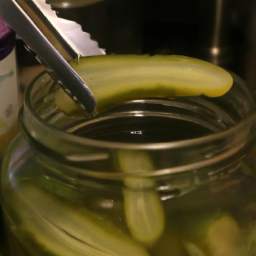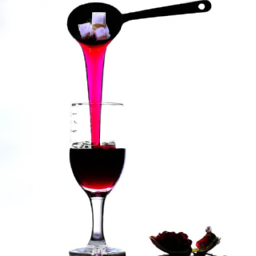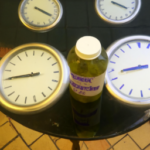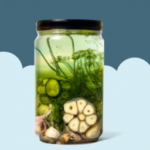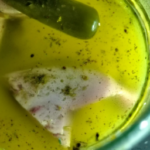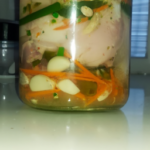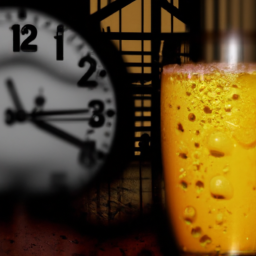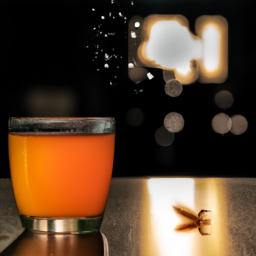As a pickle enthusiast, I know the struggle of having excess pickle juice. Pouring it down the drain is not a good idea as it can harm the environment and clog pipes.
In this article, I will guide you through the proper ways to dispose of pickle juice, as well as provide some creative uses for it.
First and foremost, it’s important to never pour pickle juice down the drain. The high acidity and salt content can damage pipes and harm aquatic life. Instead, consider using it for cooking, cleaning, or even as a home remedy.
With a little creativity, you can find many uses for pickle juice that not only prevent waste but also provide benefits for yourself and your surroundings.
Key Takeaways
- Improper disposal of pickle juice can harm the environment and clog pipes.
- Pickle juice can be reused for cooking, cleaning, and home remedies.
- Pickle juice can be composted, used for stain removal, cleaning, and pickling.
- Pickle juice can balance the pH levels of skin and soil.
Proper Disposal of Pickle Juice
Don’t just pour that pickle juice down the drain, there’s a proper way to dispose of it!
One of the best ways to dispose of pickle juice is to reuse it. Pickle juice has numerous health benefits, including aiding in digestion, reducing muscle cramps, and even helping to regulate blood sugar levels. It can also be used to add flavor to a variety of dishes, such as salad dressings, marinades, and even cocktails.
If you don’t plan on reusing your pickle juice, it’s important to dispose of it properly. Pouring it down the drain can harm the environment and potentially clog your pipes. Instead, consider adding it to your compost or using it as a natural cleaning solution.
With so many ways to reuse or dispose of pickle juice, there’s no reason to let it go to waste.
Now, let’s talk about how to use pickle juice in your cooking.
Cooking with Pickle Juice
Using leftover brine from pickles can add an irresistible tanginess to your dishes. If you’re looking to add some depth to your marinades, consider using pickle juice. The acidity in the brine can help tenderize meat and add a unique flavor profile.
Here are some ways to incorporate pickle juice into your cooking:
- Use pickle juice as a base for a salad dressing. Mix it with olive oil and your favorite herbs for a simple and tangy vinaigrette.
- Pickle vegetables in leftover pickle juice. This is a great way to use up any leftover vegetables in your fridge and create a tasty side dish for your meals.
- Add pickle juice to your coleslaw. The acidity in the brine can help cut through the creaminess of the dressing and add a zesty kick to your slaw.
- Use pickle juice in your marinades. The acid in the brine can help break down the proteins in meat and make it more tender. Try using pickle juice in a marinade for chicken or pork.
Now that you know some ways to use up your leftover pickle juice in the kitchen, let’s move on to the next topic: drinking pickle juice.
Drinking Pickle Juice
If you’re feeling adventurous, you might want to try sipping on some of that leftover brine from your favorite pickled veggies. Drinking pickle juice for health is not a new concept. It has been touted as a remedy for muscle cramps, dehydration, and even hangovers.
This is because pickle juice contains electrolytes, such as sodium, potassium, and magnesium. These minerals help to replenish the body’s electrolyte levels, which can be depleted during long periods of physical activity. In fact, some athletes have started using pickle juice as a sports drink alternative.
It’s believed that drinking pickle juice before or during exercise can help improve muscle function, reduce cramps, and aid in recovery. However, it’s important to note that pickle juice is high in sodium, so it should be consumed in moderation. If you’re not a fan of the taste, you can also try mixing it with water or adding it to a smoothie.
Now, let’s move on to the next section about using pickle juice for cleaning.
Using Pickle Juice for Cleaning
One surprising way to repurpose the tangy liquid in your jar of pickles is to harness its cleaning power. Here are four ways you can use pickle juice for cleaning:
-
Stain removal: The acidic nature of pickle juice makes it a great stain remover for clothing and carpets. Simply dab a small amount of pickle juice onto the stain and let it sit for a few minutes before washing or rinsing it away.
-
Cleaning copper: The vinegar and salt in pickle juice make it an effective cleaner for copper cookware and utensils. Simply soak the copper item in pickle juice for a few minutes before rinsing and drying it off.
-
Removing rust: The vinegar in pickle juice can also help remove rust from metal surfaces. Soak the rusty item in pickle juice for a few hours or overnight before scrubbing it with a brush and rinsing it with water.
-
Pickling vegetables: Don’t let the leftover pickle juice go to waste! You can use it to make your own pickled vegetables, such as cucumbers or carrots. Simply add the veggies to the jar of pickle juice and let them sit in the fridge for a few days to pickle.
Aside from its cleaning capabilities, pickle juice can also be used in beauty and personal care.
Pickle Juice in Beauty and Personal Care
In the world of beauty and personal care, pickle juice can work wonders for your skin and hair. It’s like a secret potion straight out of a fairy tale. Pickle juice benefits include balancing the pH level of your skin, making it an excellent toner. It also has antibacterial properties that can help fight acne and improve skin texture.
DIY beauty enthusiasts can even mix pickle juice with other ingredients like honey or avocado to create a nourishing face mask. But the benefits of pickle juice don’t stop at skincare. Pickle juice hair care is also gaining popularity, with many claiming that it can help reduce dandruff and promote hair growth.
The vinegar in pickle juice can help remove buildup on the scalp, while the antioxidants in the juice can nourish hair follicles. Whether you’re looking for a natural alternative to commercial hair care products or just want to try something new, incorporating pickle juice into your beauty routine might just be the answer.
When it comes to gardening, pickle juice has a surprising use that can benefit your plants.
Pickle Juice in Gardening
You may be surprised to learn that the tangy liquid left over from your favorite pickles can actually be a valuable ingredient in your gardening routine. Using pickle juice as a fertilizer can provide your plants with essential nutrients like potassium, phosphorus, and calcium. Additionally, the acidic nature of pickle juice can help balance the pH levels of your soil, promoting healthy growth for your plants.
If you’re interested in incorporating pickle juice into your compost, it can also be a great addition. The high levels of vinegar in pickle juice can act as a natural preservative, helping to break down the organic matter in your compost more efficiently. Just be sure to dilute the pickle juice with water before adding it to your compost pile to avoid overpowering the other ingredients.
Transitioning into the subsequent section about ‘pickle juice for pets’, it’s important to note that while pickle juice can be beneficial for your plants and compost, it’s not always safe for your furry friends. Let’s explore some of the potential risks and benefits of using pickle juice for your pets.
Pickle Juice for Pets
If your furry friend is a fan of tangy flavors, incorporating pickle juice into their diet could provide them with some unexpected health benefits. Pickle juice is rich in electrolytes, which can help keep your pet hydrated and replace any minerals lost during exercise or hot weather. It also contains antioxidants that may boost their immune system and reduce inflammation.
In addition to its nutritional benefits, pickle juice can also be used as a training aid. Many dogs are motivated by food rewards, and pickle juice can be an effective way to give them a tasty treat while also encouraging good behavior. Just be sure to dilute the juice with water before feeding it to your pet, as too much sodium can be harmful.
Transitioning into the subsequent section about ‘pickle juice for home remedies’, it’s important to note that while pickle juice can be a useful tool for pet health and training, it can also be used for a variety of other purposes around the home.
Pickle Juice for Home Remedies
I’ve found that pickle juice can be a helpful home remedy for relieving heartburn and reducing muscle cramps. The acidic nature of the vinegar in pickle juice can help to neutralize stomach acid and alleviate heartburn discomfort.
Additionally, the electrolytes and minerals in pickle juice can help to prevent and ease muscle cramps.
Relieving heartburn
Relieving heartburn can be achieved by drinking pickle juice. It may seem like an unorthodox method, but pickle juice has been used as a natural remedy for heartburn for years. It works by increasing the acidity in the stomach, which can help to neutralize the acid that’s causing the discomfort.
Here are 4 reasons why pickle juice is an effective solution for heartburn relief:
- It contains vinegar, which stimulates acid production in the stomach.
- It has a high salt content, which helps to neutralize excess acid.
- It contains antioxidants that can help to reduce inflammation in the digestive tract.
- It can promote digestion and help to relieve bloating, which can be a contributing factor to heartburn.
Reducing muscle cramps can also be accomplished by incorporating pickle juice into one’s daily routine.
Reducing muscle cramps
Imagine a world where muscle cramps no longer hold you back from your daily activities – all you need to do is add a simple, yet effective solution to your routine. That solution is drinking pickle juice. Yes, you read that right. Pickle juice has been found to reduce muscle cramps by up to 37%, according to a study published in the Journal of Athletic Training.
But how does pickle juice work? Pickle juice contains vinegar, which helps reduce dehydration and improve athletic performance. When we exercise, our muscles produce lactic acid, which can lead to cramping. The vinegar in pickle juice triggers a reflex in the mouth, sending a signal to the brain to inhibit the firing of neurons in the muscle that are causing the cramp. This reflex can occur within seconds, making pickle juice a quick and effective remedy for muscle cramps.
And now, onto the next topic – pickle juice in cocktails.
Pickle Juice in Cocktails
I’m excited to discuss the potential of pickle juice in cocktails.
Adding pickle juice to drinks can create a unique twist and add a tangy flavor to traditional cocktails.
Additionally, pickleback shots have gained popularity in recent years. They consist of a shot of whiskey followed by a shot of pickle juice and can be a fun addition to any party.
Adding a unique twist to drinks
Mixing pickle juice into cocktails can add a tangy and unexpected twist to your drink. It’s all about creating unique flavor combinations that excite your taste buds.
Pickle juice is a versatile ingredient that can be used in a variety of cocktails, from classic martinis to refreshing margaritas. You can even use pickle juice to create pickle juice mocktails for those who prefer non-alcoholic beverages.
One great way to incorporate pickle juice into your cocktails is by creating pickleback shots. These shots consist of a shot of whiskey followed by a shot of pickle juice, and they’re a popular option for those who want to add a little extra flavor to their drinks.
The acidity of the pickle juice helps to cut through the strong flavor of the whiskey, creating a perfectly balanced shot. Plus, it’s a fun and unexpected way to serve drinks that your guests are sure to love.
Creating pickleback shots
As someone who loves to experiment with unique flavors in my drinks, I have recently discovered the wonders of pickleback shots. This popular drink combines a shot of whiskey with a chaser of pickle juice, creating a tangy and savory flavor that is surprisingly refreshing. Not only is it a fun way to mix up your usual drinking routine, but it also provides a use for leftover pickle juice that might otherwise go to waste.
But pickle juice isn’t just limited to being a drink mixer. It can also be used in cooking, particularly as a marinade or brine for meats and vegetables. The acidity in the pickle juice helps to tenderize and flavor the food, creating a delicious and unique taste. Additionally, pickle juice can even be used in baking, such as in bread or cake recipes, to add a subtle tanginess to the finished product. So next time you find yourself with leftover pickle juice, don’t throw it away – get creative and find a new way to incorporate it into your meals.
| Pros | Cons |
|---|---|
| Adds unique flavor to drinks | Can be too strong for some tastes |
| Provides use for leftover pickle juice | May not be suitable for all types of cuisine |
| Can be used in marinades and baking | May require experimentation to find the right balance |
| Adds tanginess to baked goods | May not be well-received by picky eaters |
Frequently Asked Questions
How long does pickle juice last in the fridge?
Did you know that pickle juice can last up to 3 months in the fridge? Reusing pickle juice for recipes and as a sports drink has benefits beyond muscle cramps, including hydration and gut health.
Can pickle juice be reused for pickling?
I can reuse pickle juice for pickling, but it’s important to note that the brine may lose some of its flavor and potency after the first use. Other pickle juice alternatives include using it as a marinade or adding it to salad dressings. Additionally, pickle juice has potential health benefits, such as aiding in digestion and reducing muscle cramps.
Is pickle juice safe to use as a marinade for meat?
Using pickle juice in cooking can add a tangy flavor to meat. However, caution should be taken as it can be high in sodium. Drinking pickle juice can provide electrolytes and aid digestion.
Can pickle juice be used to clean silverware?
Pickle juice has cleaning benefits for silverware due to its acidic properties. It can remove tarnish and restore shine. In addition, pickle juice has alternative uses such as a sports drink or in cocktails.
Does drinking pickle juice really help with muscle cramps?
Drinking pickle juice may help alleviate muscle cramps due to its high sodium and electrolyte content. However, the benefits vs risks should be considered, and alternatives like stretching and hydration should also be explored. One thing’s for sure, pickle juice won’t magically make you a superhero.
Conclusion
In conclusion, disposing of pickle juice properly is important for both environmental and health reasons. While it may be tempting to pour it down the drain, it’s better to either reuse it in cooking, cleaning, or beauty and personal care, or to dispose of it in the trash.
Drinking pickle juice can provide some health benefits, but it’s important to do so in moderation and avoid consuming it if you have health conditions that may be negatively affected by its high sodium content.
Overall, pickle juice is a versatile liquid that can be used in many ways beyond just pickling vegetables. From cleaning to gardening to home remedies, pickle juice has many practical applications.
As the saying goes, "one person’s trash is another person’s treasure."So next time you have leftover pickle juice, consider giving it a second life instead of simply throwing it away.
Ilana has been a vegan for over 10 years. She originally made the switch for health reasons, but soon found herself becoming more and more passionate about the ethical and environmental implications of a vegan lifestyle. Ilana is the author of The Graceful Kitchen, a blog all about veganism. She loves to cook up delicious and nutritious vegan meals, and share her recipes with others who are interested in leading a cruelty-free life. Ilana is also a strong advocate for using whole foods as the foundation of a healthy diet, and believes that going vegan is one of the best ways to achieve this.
